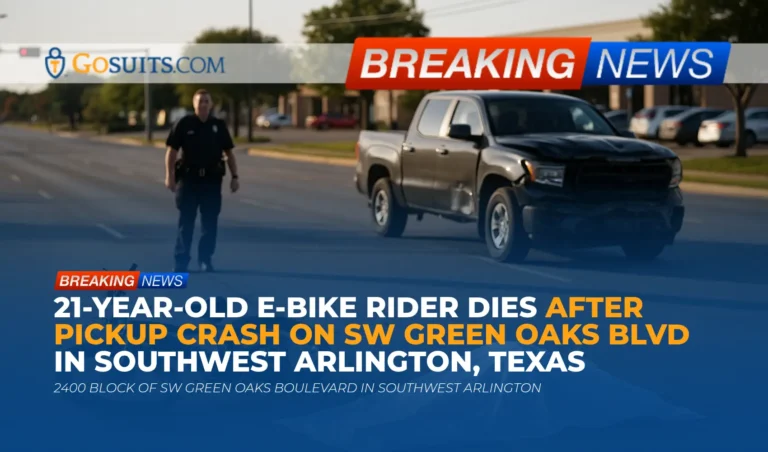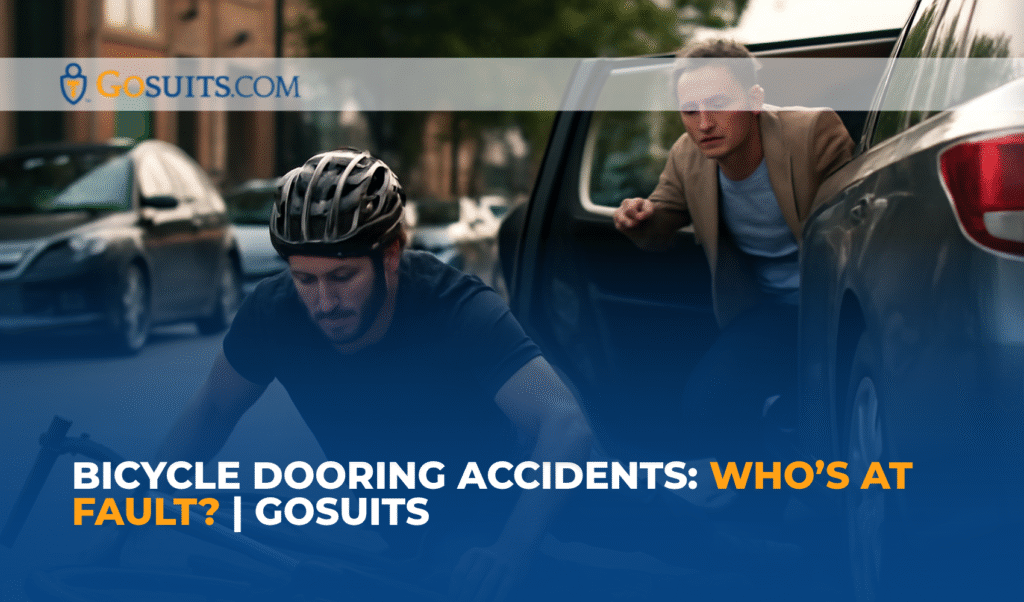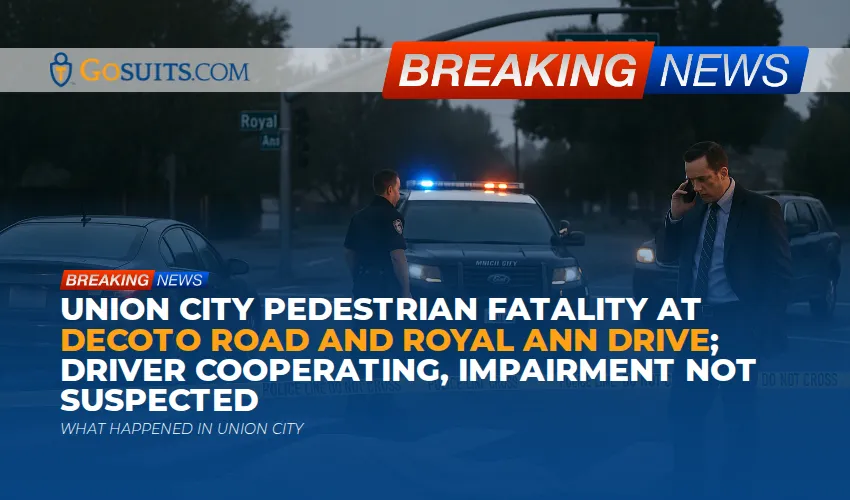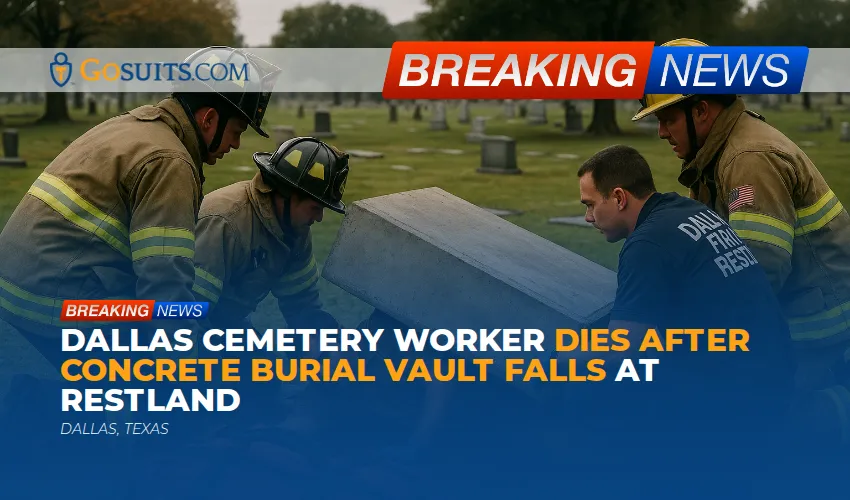- What we know about the Southwest Arlington e-bike and pickup crash
- Location and timeline
- Official sources and how to obtain records
- Texas traffic laws relevant to this collision
- Civil liability and insurance considerations
- What families can do in the first days after a fatal crash
- E-bike safety and crash trends
- Commentary from Gosuits Arlington, Texas Personal Injury Attorney
- Next steps: time sensitive actions that protect legal rights
- Sources
What we know about the Southwest Arlington e-bike and pickup crash
Authorities reported that a 21-year-old rider, identified by the Tarrant County Medical Examiner as Tariq Muhammad, died after a collision involving his electric bicycle and a pickup truck in Southwest Arlington. According to information relayed by the Arlington Police Department, the crash occurred on Sunday, October 26, just before 5 p.m. in the 2400 block of SW Green Oaks Boulevard. Investigators stated the pickup was exiting a parking lot to turn westbound when the rider collided with the truck. The impact threw Mr. Muhammad from the bike. He was transported to a hospital and passed away a few hours later. Police noted the driver stopped immediately, remained at the scene, cooperated with the investigation, and was not cited for intoxication or speeding. Law enforcement also indicated there were no criminal charges associated with this crash at the time of reporting.
These early details offer a factual framework. They do not resolve civil fault, which typically requires a deeper evaluation of roadway design, sightlines, right-of-way rules, driver conduct, rider conduct, and any available video or electronic data. Even in incidents where no traffic citation is issued and no criminal charges are brought, civil liability can still be examined under Texas law using a different set of standards and burdens of proof than those used in criminal or traffic enforcement decisions.
Location and timeline
Time and date: October 26, shortly before 5 p.m. Daylight conditions can vary, and dusk around late October can affect visibility, especially near driveways and parking lot exits. Without speculating on specific lighting or weather conditions at the exact minute of this crash, investigators often review environmental factors alongside physical evidence.
Location: 2400 block of SW Green Oaks Boulevard in Southwest Arlington. This corridor typically carries steady traffic and includes commercial driveways along segments of the roadway. Parking lot exits introduce what traffic engineers call conflict points, where vehicles, cyclists, and pedestrians cross paths as drivers enter or leave access points. At these locations, Texas right-of-way rules and prudent visual scanning are critical for all road users, including drivers looking for approaching roadway traffic and cyclists operating along the main thoroughfare or near curb cuts.
Immediate aftermath: Responding officers found that the rider had already been taken to the hospital. He later died from his injuries. The driver was uninjured and remained at the scene.
Official sources and how to obtain records
In a fatal crash, several official records become important for understanding what happened and for any later insurance or civil claims. The following government sources can help families and community members locate accurate documentation.
Police crash reports and records
In Texas, when a crash results in injury or death, a law enforcement officer’s crash report is required. Under Texas Transportation Code section 550.062, an officer who investigates a motor vehicle crash that results in injury or death must submit a report to the Department of Transportation. Crash reports are typically accessible to authorized individuals through the statewide system.
- Arlington Police Department: The police department’s records or open records page provides information on requesting incident reports or related records. Visit the City of Arlington’s official police page here: Arlington Police Department.
- TxDOT Crash Report Purchase System: Eligible requesters can often obtain the Texas Peace Officer’s Crash Report online through the Texas Department of Transportation’s system: TxDOT Crash Report Purchase System.
Requesters should be prepared with key details such as date, location, and parties involved. There can be a short processing period before reports are available.
Medical examiner and autopsy records
When a death is sudden or unexpected, the county medical examiner investigates the cause and manner of death. In Tarrant County, the Medical Examiner’s Office manages autopsy and related documentation.
- Tarrant County Medical Examiner’s Office: Information about case records, next of kin notifications, and how to request records is available at the county site: Tarrant County Medical Examiner.
Next of kin can typically request certain records directly from the Medical Examiner’s Office. Some documents may have restrictions or redactions consistent with Texas law.
Death certificates and vital records
- Texas Department of State Health Services Vital Statistics: Certified death certificates are available through the state’s Vital Statistics office. Guidance and applications are available here: Texas Vital Statistics.
Death certificates are often required for insurance claims, estate matters, and other legal processes.
Hospital and EMS records
If emergency medical services transported the patient and a hospital provided care, those entities maintain their own records. Next of kin or an authorized representative can request medical records. Release typically requires proper authorization and identification.
Texas traffic laws relevant to this collision
Texas law recognizes that people riding bicycles have the same rights and duties on the roadway as drivers of vehicles, with some specific provisions unique to bicycles and micromobility devices. Key statutes often examined in collisions like this include:
Rights and duties of bicyclists
- Rights and duties: Under Texas Transportation Code section 551.101, a person operating a bicycle has the rights and is subject to the duties applicable to a driver operating a vehicle by law, except for special regulations applying to bicycles and those provisions that by their nature cannot apply. See: Tex. Transp. Code § 551.101.
Emerging from a driveway or parking lot
- Duty to stop and yield: Texas Transportation Code section 545.256 requires a driver emerging from an alley, driveway, or building to stop before a sidewalk or sidewalk area and yield the right-of-way to any pedestrian or approaching vehicle on the roadway. This provision often applies to vehicles exiting parking lots. See: Tex. Transp. Code § 545.256.
Investigations typically examine whether a driver exiting private property made an appropriate stop and adequately scanned for traffic, including bicycles and other roadway users, before entering the roadway. They also examine the rider’s position and movement in relation to the driveway apron and main travel lanes.
Electric bicycle classification
- Definition and classes: Texas classifies electric bicycles by assisted speed and motor cut-off parameters under Chapter 664 of the Transportation Code. The classes distinguish levels of pedal assist and throttle control. See: Tex. Transp. Code ch. 664.
While class designation helps determine where a device may be operated, civil fault assessments are still grounded in general roadway duties of care, right-of-way, and prudence under the circumstances.
Officer crash reports in injury or fatality events
- Officer report requirement: Texas Transportation Code section 550.062 addresses an officer’s obligation to file a crash report with TxDOT for crashes involving injury or death. See: Tex. Transp. Code § 550.062.
Civil liability and insurance considerations
Determining civil liability is a separate process from deciding criminal charges or issuing traffic citations. It involves evaluating whether one or more parties failed to act with reasonable care and whether that failure caused the harm. In Texas, several legal concepts guide that analysis in wrongful death and serious injury cases.

Wrongful death and survival claims
- Wrongful death: Texas law allows certain family members to bring a claim when a death is caused by the wrongful act, neglect, carelessness, unskillfulness, or default of another. Statutory provisions include who may bring the claim and the nature of recoverable damages. See: Tex. Civ. Prac. & Rem. Code ch. 71.
- Who may bring the claim: Typically the spouse, children, and parents may bring a wrongful death claim individually or together. See: § 71.004.
- Survival action: The estate may also pursue a survival claim for damages the decedent could have recovered if they had lived, which then survive to the estate. See: § 71.021.
- Time limits: Wrongful death and personal injury claims are generally subject to a two year limitations period. See: § 16.003.
Families navigating these questions often need to gather records promptly and understand which claims belong to which parties.
Comparative negligence and proportionate responsibility
- Texas proportionate responsibility: Texas follows a modified comparative negligence system. A claimant is barred from recovery if they are more than 50 percent responsible for the harm. If they are 50 percent or less responsible, recoverable damages are reduced by their percentage of responsibility. See: Tex. Civ. Prac. & Rem. Code § 33.001.
In practical terms, fault can be shared among multiple parties. In a driveway exit scenario, investigators typically consider whether a driver yielded appropriately and whether a rider’s path, speed, or position changed the timing of the conflict. The physical environment, including sight obstructions near that driveway, can also be relevant.
Insurance that may be implicated
- Driver’s auto liability insurance: This is often the first policy evaluated when a motor vehicle is involved.
- Uninsured and underinsured motorist coverage: A bicyclist’s own auto policy may include UM or UIM benefits that apply even when the person is riding a bicycle.
- Personal Injury Protection or MedPay: Some Texas auto policies include PIP or optional medical payments coverage that may be available regardless of fault, subject to policy terms.
- Home or renter policies: These typically exclude motor vehicle claims and often have exclusions for motorized bikes, but wording varies. Policies should be reviewed carefully.
Insurance communications can have significant consequences. Statements made to an insurer can affect fault allocations and claims valuation. It is prudent to consult an attorney before providing recorded statements or detailed timelines to any insurer. What someone says to an insurance company can be used against them later.
Evidence to evaluate in driveway exit crashes
- Police crash report and scene diagram
- Body worn camera footage if available through lawful request
- Business surveillance video from parking lot exits or adjacent storefronts
- Event data from the vehicle, if applicable, and any device data logs from the e-bike controller or rider devices
- Lighting and sightline assessments, including parked vehicles or landscaping near the driveway
- Physical evidence such as scrape marks, debris field, final rest positions, and helmet or equipment condition
- Medical records documenting the mechanism and severity of injuries
What families can do in the first days after a fatal crash
In the wake of a tragic loss, it is understandable to feel overwhelmed. The following practical steps can help protect information and rights without adding unnecessary strain.
Preserve evidence quickly
- Request preservation of video: Many businesses overwrite surveillance footage within days or weeks. A written preservation request to nearby businesses along the 2400 block of SW Green Oaks Boulevard can be crucial, especially those with cameras facing the parking lot entrance or roadway.
- Secure the e-bike and helmet: Store the equipment in its post crash condition. Do not repair, dispose of, or alter it until it can be inspected. Retain any accessories such as lights, camera mounts, or GPS devices.
- Photograph the scene as it is now: Even if conditions have changed, photos of driveway geometry, signage, landscaping, or line of sight may be valuable.
Organize essential documents
- Record numbers: Keep the police incident number, case officer name, and the TxDOT crash report number if available.
- Medical paperwork: Save hospital discharge or physician summaries, even if brief.
- Funeral and related expenses: Keep receipts and invoices for potential reimbursement under applicable claims.
Be cautious with insurance communications
- Consult an attorney first: Before contacting any insurance carrier for recorded statements or detailed questionnaires, consider seeking a free consultation with a personal injury attorney. Insurers may use statements in later fault evaluations.
- Limit social media discussion: Public posts can be collected and used in claims assessments.
Support for emotional and practical needs
- Crisis and mental health resources: The SAMHSA National Helpline offers confidential support and referrals 24 hours a day. Learn more here: SAMHSA National Helpline.
E-bike safety and crash trends
Electric bikes offer accessible mobility, but like all roadway travel, they present risk. Understanding broader trends can provide context for safety and prevention discussions in local communities.
- National bicyclist fatalities: In 2022, 1,105 bicyclists and other cyclists were killed in traffic crashes in the United States, a continuation of an upward trend in recent years, according to the National Highway Traffic Safety Administration. See NHTSA traffic safety facts: NHTSA 2022 Bicyclists Traffic Safety Facts.
- Urban environments: Most bicyclist fatalities occur in urban areas and often at non intersection locations, though driveways and access points create additional conflict areas that warrant attention to scanning and yielding behavior. See NHTSA fact sheets above.
- Micromobility injuries: The U.S. Consumer Product Safety Commission has reported increasing injuries associated with micromobility products, including e-bikes. While national data aggregates a range of devices and does not assign fault in individual incidents, it underscores the need for visible lighting, predictable riding, and vigilant scanning by all road users. See: CPSC Micromobility Safety.
- Helmet use: The Centers for Disease Control and Prevention emphasizes that a properly fitted helmet reduces the risk of head injury for bicycle crashes. See: CDC Bicycle Safety.
Local prevention efforts often focus on driveway exit design, trimming vegetation that blocks sightlines, adequate lighting, roadway markings near access points, and public awareness for both drivers and cyclists regarding yielding and scanning responsibilities.

Commentary from Gosuits Arlington, Texas Personal Injury Attorney
Our hearts go out to the family and friends of the young rider who lost his life. Losing someone so suddenly is devastating. This article is meant for educational purposes and general information, and it is not a substitute for personalized guidance about any specific situation.
From a civil injury perspective, driveway exit crashes are complex. Texas law requires drivers emerging from driveways or parking lots to stop and yield to approaching traffic. Bicyclists generally share the same roadway rights and duties as drivers. In a scenario like the one described on SW Green Oaks Boulevard, a careful analysis typically looks at driver yielding behavior, the rider’s path and timing, lines of sight near the driveway, and the presence or absence of obstructions. Even when a criminal charge is not pursued, it remains appropriate to examine civil responsibility using the proportionate responsibility rules in Texas. Evidence such as surveillance video, physical markings on the roadway, vehicle and e-bike condition, and medical documentation can be decisive in understanding what happened.
Insurance companies and corporate defendants often move quickly to shape the narrative of a crash. They may take recorded statements before all facts are known, emphasize incomplete details, or ask broad authorizations to access records. Without a full evidentiary picture, families can be placed at a disadvantage. Adjusters work within policy terms and cost containment mandates, and they may rely on technical policy exclusions or interpretations that are not obvious to a layperson. Preserving and gathering the right evidence early can help level the playing field.
A free consultation with a seasoned personal injury attorney can clarify the difference between criminal and civil standards, identify what evidence to request immediately, and explain how Texas wrongful death and survival statutes may apply. It can also help families understand how proportionate responsibility might be argued by insurers and what steps are needed to protect potential claims while respecting the mourning process.
Next steps: time sensitive actions that protect legal rights
The following steps are general guidance about what to do after a fatal roadway crash. They are included to explain why acting promptly can matter. They are not directed at any specific person.
- Secure official records: Obtain the police crash report through the TxDOT Crash Report Purchase System once available, request any supplemental reports, and confirm the case number with the investigating agency. Early access to the official narrative can guide further requests for evidence.
- Request medical examiner documentation: Next of kin can ask the county medical examiner about available records and timelines. Autopsy and investigative findings may clarify the mechanism of injury and timing, which can be important in civil evaluations.
- Preserve surveillance video immediately: Many business systems overwrite video within days. Send written preservation requests to nearby businesses and property managers near the driveway exit and along the roadway.
- Protect the e-bike and personal equipment: Keeping the bike, helmet, and accessories unchanged allows for expert inspection, imaging, and, if appropriate, testing. Alteration or disposal can impede accurate reconstruction.
- Consult an attorney before insurance communications: Recorded statements to any insurer can affect later determinations of fault and damages. Consultation helps ensure that rights are not inadvertently compromised. What is said to an insurance company can be used later.
- Track expenses and losses: Funeral costs, medical bills, and related expenses should be documented from the start. Organized records help with any claims that may be available under wrongful death or survival provisions.
- Mind critical deadlines: Texas generally imposes a two year limitations period for wrongful death and personal injury claims. Certain notice requirements may apply sooner, and evidence like video or vehicle data can be lost within days or weeks, making early action important even while a family grieves.
- Consider estate steps: Survival claims belong to the estate. Depending on circumstances, opening an estate proceeding may be necessary to handle legal matters and to appoint a representative who can request records and pursue applicable claims.
These steps are intended to help people understand the urgency and context of evidence preservation, records access, and time limits after a serious crash. The goal is to make informed decisions at a measured pace and with clarity about rights and options.
Sources
- Texas Transportation Code § 551.101
- Texas Transportation Code § 545.256
- Texas Transportation Code ch. 664
- Texas Transportation Code § 550.062
- Texas Civil Practice and Remedies Code ch. 71
- Texas Civil Practice and Remedies Code § 71.004
- Texas Civil Practice and Remedies Code § 71.021
- Texas Civil Practice and Remedies Code § 16.003
- Texas Civil Practice and Remedies Code § 33.001
- TxDOT Crash Report Purchase System
- City of Arlington Police Department
- Tarrant County Medical Examiner’s Office
- Texas Department of State Health Services Vital Statistics
- NHTSA 2022 Bicyclists and Other Cyclists Traffic Safety Facts
- U.S. Consumer Product Safety Commission Micromobility Safety
- CDC Bicycle Safety
- SAMHSA National Helpline






